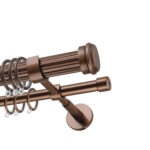Assembling and installing curtain rod
Window decoration is one of the key tasks of interior design. A correctly selected combination of textile fabric and its fastening above the opening will give the room a complete, maximally harmonious look. Installing curtain rods is not as difficult as it might seem.
Varieties of curtain rods
The cornice is not only a functional, but also a decorative element. Therefore, you need to carefully consider the choice of the product to which the curtain will be attached. To understand which one is suitable for the room, you need to take into account the material of the cornice and curtains, the structure, the way in which it is attached above the window.
By construction type
By design, the cornice can be:
- wall-mounted;
- ceiling.
The wall type is the most popular. It is simple to install and easy to use.
Ceiling mounting makes the room visually more spacious. The effect can be enhanced by choosing curtains with a pattern of vertical lines.
This design is ideal for rooms with a window to the ceiling. It can be harmoniously integrated into any design.
Important! The disadvantage of a ceiling cornice is that it must be chosen at the stage of rough repair work. But its pluses cover this nuance.
By fastening method
Curtains can be attached to the cornice in different ways.
Possible options:
- Loops, which are sewn to the top edge of the textile fabric, and then put on the curtain rod. They can be made of the same material as the curtain, or made of different fabrics, ribbons, cords. A convenient solution that allows you to remove the curtains at any time, for example, for washing, is to use the buttonholes.
- Eyelets - only suitable for rod designs. In the upper part of the canvas, holes are made into which eyelets (plastic, metal or wooden rings) are inserted, then the cornice is threaded. Large beautiful folds are obtained.
- Hooks (clamps) - for string construction. Fasteners are hung on the string - hooks or clothespins. Then the curtain clings to them.
- Hook-loop tape that is sewn to the top of the fabric.
- The curtain is a "pocket" on the canvas through which the cornice rod passes. You can hang the canvas straight or arrange it in the form of folds.
The option is selected, first of all, taking into account the design of the cornice. Pay attention to the density of the fabric, do not miss the compatibility with the interior.
By material
Cornices can be made from the following materials:
- Wood is a classic and noble material. It can be harmoniously fit into almost any interior concept. In production, wood is treated with anti-rotting compounds. Wooden curtain rods are strong, beautiful and durable.
- Metal is a popular solution. Copper, stainless steel, brass, aluminum, chrome, nickel are used.
- Plastic is an inexpensive material that does not require special care. High-quality PVC curtain rods are incredibly wear-resistant and durable.
Any of these three materials are good enough. It is worth choosing based on aesthetic preferences and the general styles of the interior of the room.
By the number of rows
Depending on how you need to arrange the window and how many layers of fabric will be used at the same time, a cornice with a certain number of rows is selected.
They are like this:
- Single row. This option is the easiest to install and use, it is intended for one canvas.
- Double row. This design is most popular due to its functional convenience: a light curtain is hung on the lower part, and a dense opaque curtain is attached to the upper bar. Thus, it is possible to provide a comfortable level of illumination in the room at any time of the day.
- Three-row. It is used less often than others, it is suitable for interiors in which a multi-layer curtain is supposed to be made of fabrics of different density. Allows you to hang a lambrequin.
Additional Information! Lambrequin is a decorative element of window framing. It is located in its upper part and should have a length of no more than 20% of the opening. Previously, the lambrequin was hung in order to hide an unsightly cornice, but now it is used only for decoration.
By way of control
Cornices are string, profile and with a bar:
- Stringing involves the use of a metal wire tensioned using an adjustment mechanism. The advantages of such a system are simplicity and low cost. But this method is not suitable for thick curtains - under the weight of textiles, the strings stretch, sag or even break. The wire cornice is well suited for light, transparent curtains, it does not attract attention, creating a visual lightness, weightlessness of the window frame.
- Another type of curtain rod is in which the curtain is fixed on movable elements built into the profile, or a tire. Fasteners move in grooves, like on rails, the design is comfortable and durable. It is possible to use swivel elements so that the curtain moves at an angle or with a turn.
- Cornice rod - can have a round or square section. Rings or eyelets are put on the base.
Please note: in large rooms where you need to use a curtain or drapery on a cornice longer than 4 meters, it is better not to use a bar-shaped structure. With this length, it tends to bend under the weight of the fabric. In such cases, it is better to pay attention to the profile structures. They make it possible to move the web without obstacles at any length. Rod rods give unimaginable scope for design solutions, they can have a complex shape, an unusual surface, and can be supplemented with special curly plugs instead of the usual ones.
Features of Curtain Rod Connector
Profile cornices can be installed in absolutely any length and shape using a connecting element for joining. Using this design, it is possible to assemble not only a straight cornice for ceiling or wall mounting, but also various curved or rounded patterns.
To implement the idea, you need to stock up on the required number of profiles and select connectors.
The eaves profile is of two types:
- Moscow;
- Turkish.
Turkish implies that the connector and decorative insert (the plug that completes the cornice prevents the hooks from jumping off the profile) add about 3 cm to the structure.

The Moscow profile is connected so that nothing is added to the size of the product. Its peculiarity: you need to take the number of profile connectors equal to the number of its rows.

Installation of curtain rods
A certain set of tools is required to install the cornice. In addition to the mounts included with the product, you will need:
- ladder;
- puncher;
- tape measure, pencil;
- dowels;
- self-tapping screws;
- building level;
Before assembling a rod-type curtain rod, you first need to determine its length and, if necessary, trim it. Then put on the curtain bar.

Important! One of the fasteners should be placed between the bracket and the decorative cover so that the curtain does not move towards the center of the rod.
You need to carefully consider the height at which the cornice will be installed. The higher the curtain starts, the more spacious the room appears.
There should be at least 5 cm between the cornice and the level of the window. If the curtain or curtain will be attached to the eyelets, do not forget to take into account the distance between the cornice and the ceiling: the fabric with rings should move freely in this space.
Installation of wall products using a string type as an example:
- Mark the place of attachment to the wall, fix the bracket holders.
- Pass the string through the hole located in the mount, fasten with screws.
- Screw the bracket to its base fixed in the wall.
- Repeat on the second side.

If the string cornice is made according to old patterns, you will need to open the box and tighten a special washer in it on the bolt on both sides.
Installation of the cornice on the ceiling:
- Drill holes in the profile at intervals of about 50 cm.
- Attach the product to the ceiling, stepping back 10-15 cm, outline the location.
- Make a hole in the center with a small drill.
- Insert a dowel into it.
- Attach the profile with a central screw.
- Align the cornice, give it the required position.
- Make the rest of the holes and hammer in the dowels.

Now fix the finished structure, on which the plugs are already installed.
How to fix the eaves bracket
To put the cornice straight, first of all, you need to outline its location with a pencil. Use a building level to avoid mistakes.
Important! For products no more than one and a half meters long, 2 brackets are enough. If the cornice is longer, an additional one is placed in the center.
Instructions:
- Measure 15-25 cm from the window on each side and make lines in these places perpendicular to the ceiling.
- From the center of the upper edge of the window, measure the required distance to the cornice and mark with a dot.
- Draw segments from a point using a level and a ruler. The places of their intersection with the lines on the sides are the points at which the brackets need to be placed.
- Place the base of the bracket against the marks and mark where the holes will be made.
- Punch holes with a puncher.
- Insert the dowels.
- Fasten the fixing part of the bracket in the dowels.
After that, you can mount the cornice itself.
How to fix a curtain rod or curtain on drywall
To put the cornice on drywall, which does not hold the usual fasteners, you need a special type of dowels - "butterflies".
When they are screwed in, the side surfaces open up and provide a firm grip on the drywall.
You can also use metal screws.

How to make a curtain rod for curtains with your own hands from scrap materials
A curtain rod for curtains is easy to make with your own hands from improvised material. The easiest way is metal or plastic pipes. For example, plumbing, 0.5 or 0.75 inches.
How to make a cornice:
- Select the diameter, length of the pipe, determine the number of brackets.
- If there are 3 fasteners, cut the pipe in half.
- At the ends of the segments, make a thread for 3-4 turns.
- From the same pipe, make pieces of 10-15 cm for each attachment and a thread at one of their ends.
- Buy or make support elements for fasteners from steel sheet 3-5 mm thick. The pipes are welded to them with the unthreaded side.
- Grind the seam.

After that, the curtain rod can be assembled, painted and installed. Paint adheres better to galvanized pipes.
Video: installation of a ceiling curtain rod























